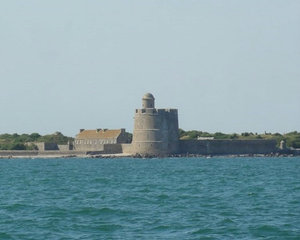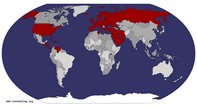Advertisement
Published: September 1st 2013

 View from Our Anchorage
View from Our Anchorage
We were sorry that we didn’t get a chance to explore St. Vaant-le-Hague when we anchored there but needed some sleep before leaving at 2:30AM.When we left Cherbourg we were headed to the town of Fecamp, but in checking the tides, we knew it was too far for a favorable current, therefore we took advice we received from others and traveled only 4 hours to an anchorage at St. Vaast-La-Hougue. It was a nice change to be at anchor as we have been in marinas most of the time while in Europe. Only problem was we knew it was not going to be for the full night as we figured we would need to leave at 2:30AM in order to catch the tide. After a few hours of rest we were ready to pull up the anchor. It was a clear, star filled morning when we left. The only confusion was created by the small, “twinkling” lights we saw everywhere – they weren’t on our chart and there seemed to be hundreds of them. We were able to figure out that they were lights that fishermen had put on their lines/traps which should have helped us with navigating around them – so much for helping! We were glad when we were able to get beyond the area where they were fishing. Just before sunrise we

 Watching the Sky
Watching the Sky
While moving from our anchorage to Fecamp we got to see a spectacular sky complete with rain showers ahead but great cloud formations and sunrise.
could see lightning and hear thunder from behind us as well as in front of us. We figured we must have been doing something right however, as the only thing we got was some great photos of clouds and the sunrise! The rest of the trip to Fecamp was calm with flat seas and no wind. Not the best for a sailboat, but fortunately we carry enough diesel so it wasn’t a problem and the current helped us some.
Fecamp had quite a bit to see – one attraction we had been told by many not to miss was the Benedictine Palace. In fact, it may look like a palace, but in fact it is the factory where Benedictine (liqueur) is produced – it is the only place in the world that this happens, here in Fecamp. The history of Benedictine started at Fecamp Abbey where the Benedictine monks lived. The monks here studied plants and found many medicinal plants such as angelica, hyssop and balm growing in the area. As a result between the 12
th & 17
th centuries they invented many elixirs. In 1509 a monk, Dom Bernardo Vincelli, was sent from Italy to Fecamp bringing spices from

 The Remaining 5 Minutes
The Remaining 5 Minutes
The sky kept changing so quickly this was the last of our 10 minutes of photos taken of the sky this morning.the Far East with him. He specialized in alchemy and the objective was to find the universal remedy and elixir for long life. He came up with an elixir that became famous throughout the region and popular for 300 years. Due to the close association between the aristocracy and the Catholic church, monks were forced to flee during the French Revolution but before they did they gave Prosper Couillard many of the artifacts and books from the Fecamp Abbey. In the mid- 1800’s Alexandre Le Grand, the grandson of Couillard found in his library a book that came from the Fecamp Abbey containing recipes of many elixirs. After many tries, in 1863 Alexandre Le Grand was able to unravel the secrets of the recipes. In tribute to the Benedictine monk that created it, he called the liqueur “Benedictine” and obtained the rights to use the coat of arms of Fecamp Abbey on the bottle. When you tour the “factory “ you get to view many of the artifacts from the Abbey which had been founded in 1001 as well as the LeGrand’s library and art collection with books from the 15
th & 16
th century and religious art work from many

 Repairing Lines
Repairing Lines
What do you do when on a passage? Bob is repairing line this time.of the churches in Germany, Italy and France. LeGrand not only wanted to share his holdings, he also wanted it to be a place of prayer and tried to recreate the atmosphere that the monks would have lived by copying some of the rooms from the Fecamp Abbey. LeGrand was a devotee of art and history and had amassed a large collection of Renaissance artifact which included many from the Abbey of the Holy Trinity in Fecamp. He wished to have the public view these and opened them to the public in 1872. Due to an increase in sales from 28,000 liters sold in 1864 to over 200,000 liters in 1879 and then again 330,000 liters in 1882 it was clear that an extension was needed. This extension done in 1882 included the addition of the current distillery that is still in use today. Guess everyone has been interested in tasting the elixir that promises a longer life!
Once you have finished touring the holdings of the “palace” you then are able to see where the Benedictine is made from a blend of 27 plants and spices from all over the world. A guide takes you through the distillery.

 Janice on watch
Janice on watch
Janice is on look out for traffic as well as enjoying the viewTo produce it must go through 4 stages – infusion with refined alcohol with an addition of vanilla and lemon peel, distillation in copper stills that were in use from the beginning in 1863 and rectification (double distillation). The 4 different “spirits” are left to age for 3 months, they are then blended together and aged for another 8 months in oak casks. The final blending includes the addition of honey and saffron and aged again in oak casks for another 4 months. It takes a total of 2 years from start of the preparation to the final product. At the end of the tour you are entitled to a tasting of 2 of their products which we both tried. It was very interesting to hear about, but this is one place where we did not buy a souvenir bottle as it was a little too strong for our taste!
Fecamp had previously been fortified in order to defend the palace of the Dukes of Normandy (Richard I and Richard II) and the monks cloistered at the Abbey of the Holy Trinity. There are remains of the palace still here which stands across from the Abbey of the Holy
Trinity which is going through a major renovation. The original Benedictine Abbey of Fecamp began in 1001, but in 1792 the French Revolution decreed the closure of all churches. Over the years additions and modifications occurred which now shows a mix of various architectural styles. It is impressive to see all of the details within this church and the magnitude of the restoration being accomplished. One item that showed the importance of the sea to the area is that of the astronomic clock. It was built in 1667 and was one of the first clocks to have 2 hands. It shows not only the hours and minutes, but also the phases of the moon, the 29 ½ days of the lunar month as well as the height of the tides at Fecamp.
The only 2 churches to survive the French Revolution were that of the Holy Trinity and the St. Stephen’s parish. St. Stephen’s was built in the 16
th century and remained unfinished until the 19
th century. It has always been known as the parish of the sea and it is still preferred by seamen. We got a chance to visit both of these while here.
As you
get closer to the harbor of Fecamp one of the sights you see is a chapel high on the cliffs. This Chapel of Our Lady of Salvation has been a navigational aid for years. It was believed that Robert, the Magnificent, Duke of Normandy (1027-1035) was saved from being shipwrecked and vowed to build 3 chapels; one being located here in Fecamp. In the 16
th century fighting caused much damage to the building and by the late 1700’s the vaulting was almost ready to collapse. Ship masts were brought up to shore it up. In 1792 it was saved from destruction due to the fact that it acted as a navigational aid to ships at sea. Fecamp had been a leading cod-fishing port from the end of the 19
th century until 1987. The cod fleet would sail to Newfoundland and return with the cod salted from the fishing grounds. There were many reminders in the church of those that had been lost at sea from the late 1800’s up to current day. They say that even today departing crews salute when they leave the harbor with three toots on their horn asking for “good wind and a fair sea”.

 Looks are Deceiving
Looks are Deceiving
The outside of the Holy Trinity Church did not tell of the beautiful interior.The cliffs that we have been seeing as we pass by the north coast of France are quite spectacular and seem to go on forever. We found out here that they are made of chalk and flint. When parts of the cliff fall into the sea, they are smoothed by the waves and the chalk exterior disappears leaving a flint shingle. During the 19
th and early 20
th century collecting these flint shingles was a source of income for many in the area. It was used as building material and in the manufacture of glass. 150,000 tons of it was hauled away in the 1860’s and in 1900 another 100,000 tons. Today it is a protected substance to reduce the destruction of the cliffs we enjoy viewing and protect the coast from the power of the sea.
Cape Fagnet, the high point to the east of the Fecamp harbor, has magnificent views as it is over 300 feet from sea level. It has been a strategic position throughout the ages – there once was a gallic fort, a fort of King Baldwin during the religious wars, a blockhouse in the German defenses of the Atlantic Wall during WWII and now

 A Lantern Tower
A Lantern Tower
The Holy Trinity Church lets light in by the use of what is called a lantern tower as seen here.is the site of a wind farm. It has seen many events occur here over time, but no matter what it is a beautiful spot to view this section of the Normandy coast. Well worth the short hike to the top!
We had originally thought we would only stay one night in Fecamp, but in fact we stayed 3 nights. The 3
rd night was an extension due to the weather forecast – we decided it would be better to wait for some wind in the right direction. We would definitely recommend this as a stop if you are traveling along this coastline.
The morning of August 5th we left for our next stop, Dieppe.
Advertisement
Tot: 0.239s; Tpl: 0.017s; cc: 15; qc: 37; dbt: 0.1331s; 1; m:domysql w:travelblog (10.17.0.13); sld: 1;
; mem: 1.2mb

























Home and Away
Bob Carlsen
You might want to edit the Entry Date to read 2 August...
and other blog Entry Dates so that your blogs are all in chronological order. I found that helpful when I blogged all my trips. Of course, that is also the engineer in me...keeping things in order.